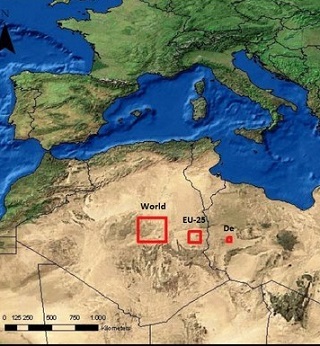More on the Path To Clean Energy

I’m not an expert in space-based anything, but it’s clear that, given the political will, we can do this all with terrestrial solar and wind, supported by other flavors of renewables, efficiency, electric transportation, smart-grid, storage, and the other peripheral technologies. The map shown above (and discussed here) shows the extremely small percentage of Northern Africa that would be required to power the entire world.
You’re most certainly right that space-based PV would require an enormous amount of international cooperation, though we need to acknowledge that this is something that’s in increasingly short supply, especially considering that the Republican-controlled U.S. Congress is going to try its best to put a spear though the progress made at the recent COP21 conference in Paris.

Craig,
I’d suggest a great deal more pessimism when it comes to space-based energy platforms. It will never happen, and it shouldn’t happen.
I don’t know what the costs are for Musk’s “dragon” launches, and I will acknowledge that he is genuinely moving the ball forward here (you know my stance on EV’s), but traditional costs of sending something into space is ~$30,000/kg.
Let’s say Musk will cut that cost in half – which I suppose is probably the upper end of what is possible.
So at $15,000 / kg of stuff we launch into space, whatever satellite that we send out there for power generation will have to deliver at least ~150 MWh/ kg over it’s lifetime to even begin to compete with terrestrial-based solar, and perhaps ~600 MWh/kg in order to compete with wind. That’s BEFORE adding in some kind of discount over time.
No-one is contemplating anything close to that, which means it’s a dead-end idea at the start. But even if one could cobble together a fictional idea of a super-solar satellite that would generate those kinds of returns, you still have the issue of delivery, and all of the delivery losses, and all of the costs of building and maintaining the receivers, etc…
It’s just a bad idea. It’s far better to concentrate on what is working and cost-effective now (hopefully improving what we have now) rather than waste millions or even billions of dollars on something that we know at the start could never approach our current cost effectiveness.
Thanks. I knew when I wrote this that you’d be along any minute to amplify the point. 🙂
I would agree with Glenn on this one – far too expensive not to mention the environmental impact of the launch with one small exception – space based solar power is the obvious way to power space infrastructure such as satellite communications and research labs.